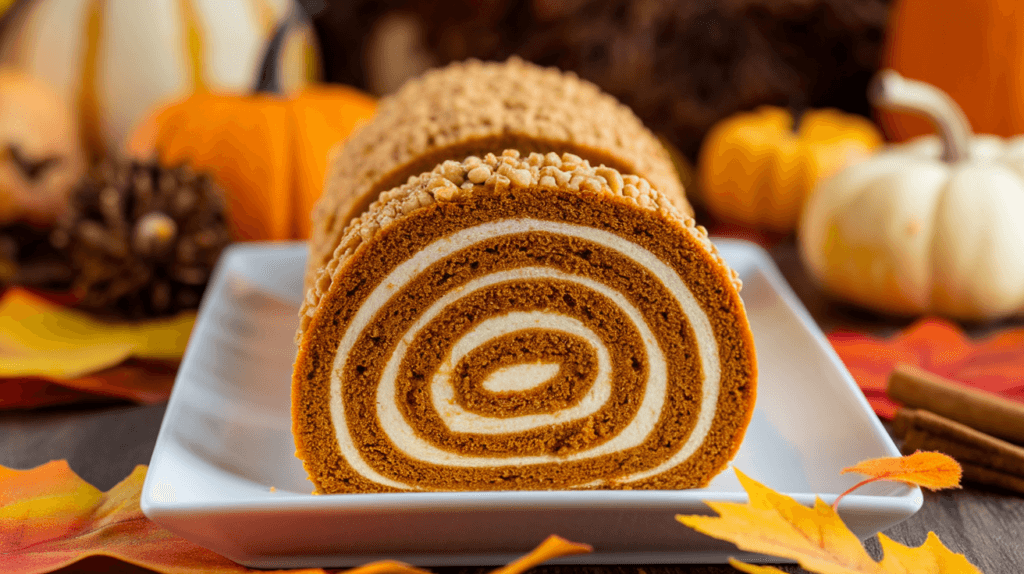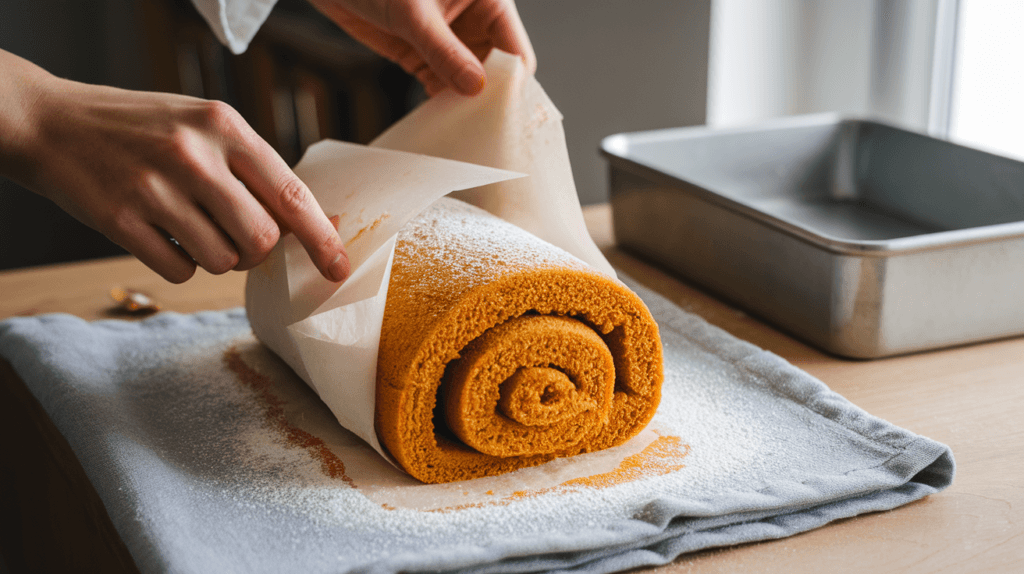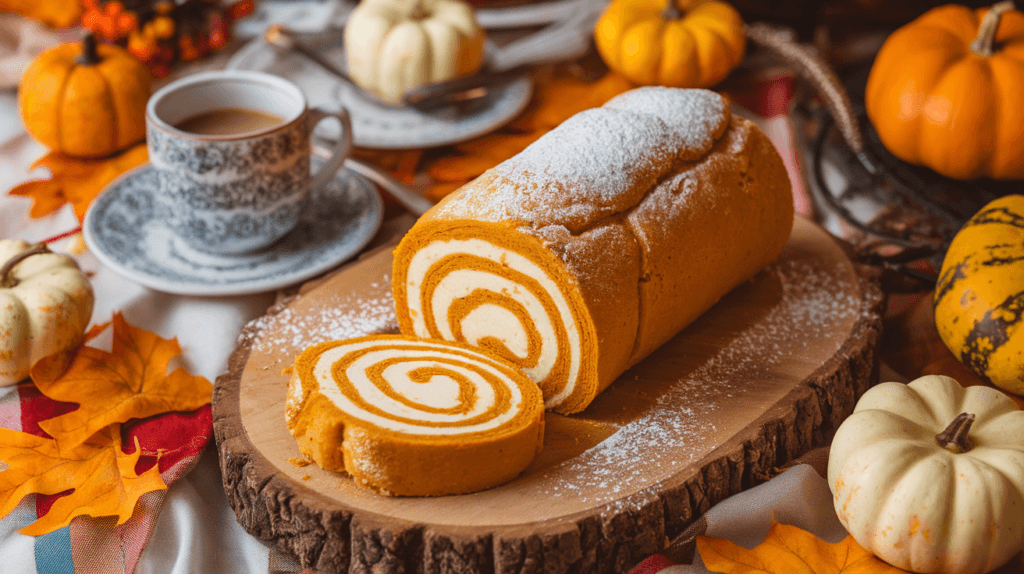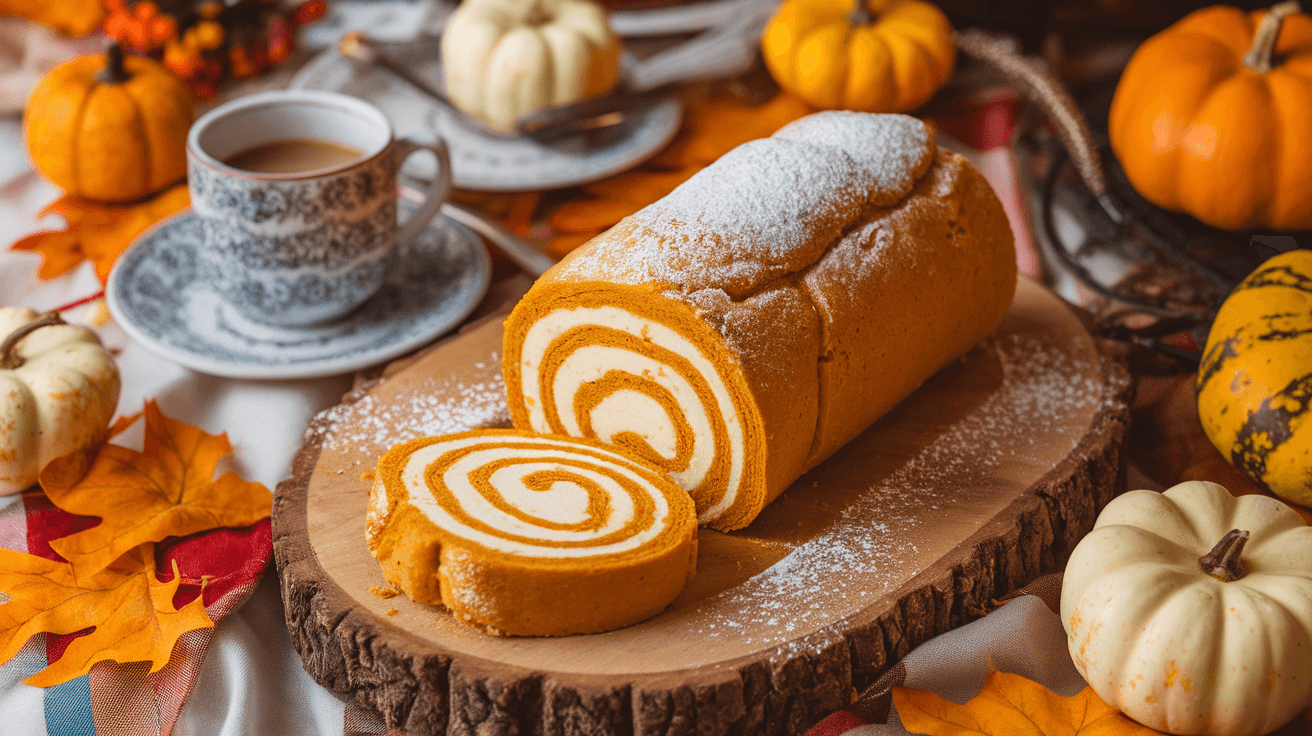Introduction
The pumpkin roll is a classic dessert, especially beloved during fall and holiday seasons. Its soft, spiced pumpkin cake wrapped around a creamy filling creates a delightful contrast of flavors and textures. But have you ever wondered what makes this dessert so special and why rolling it can be so tricky?
Rolling a pumpkin roll correctly is an art that combines skill, technique, and precision. Whether you’re a beginner or an experienced baker, achieving that perfect spiral without cracks or breaks can be challenging. In this guide, we’ll uncover the secrets to rolling a pumpkin roll like a pro.
What is a Pumpkin Roll?

A pumpkin roll is a thin sheet cake made with pumpkin puree and warm spices like cinnamon, nutmeg, and ginger. Once baked, it is carefully rolled around a creamy filling, often made with cream cheese, to create a beautiful swirl when sliced. The visual appeal and irresistible flavor make it a favorite on dessert tables.
Why Rolling Matters
The rolling process is critical to the success of a pumpkin roll. A well-rolled cake creates the iconic swirl, ensures even distribution of filling, and gives the dessert its signature look. However, improper rolling can lead to cracks, tears, or uneven layers that detract from both the appearance and taste.
As we delve deeper into this article, you’ll learn everything from the basic techniques to expert tips and common mistakes to avoid, ensuring your pumpkin roll turns out perfectly every time. Let’s get started!
Understanding the Basics of a Pumpkin Roll
What Makes a Pumpkin Roll Special?
The pumpkin roll stands out among desserts because of its unique combination of flavors, textures, and visual appeal. What is the secret to rolling a pumpkin roll? It lies in mastering the delicate balance between technique and flavor. The cake itself is tender and moist, with earthy pumpkin flavors complemented by warm spices like cinnamon and nutmeg. Many bakers wonder, what is the secret to rolling a pumpkin roll without cracks? The answer includes preparing the cake correctly and using the right filling-to-cake ratio. The creamy filling provides a sweet, tangy contrast that balances the spiced cake perfectly. If you’ve ever asked yourself, what is the secret to rolling a pumpkin roll, this guide will help you achieve a flawless, spiral-shaped dessert every time.
What truly makes it special is its aesthetic. The swirled layers of cake and filling not only taste amazing but also create an elegant presentation. It’s a dessert that never fails to impress, whether served at family gatherings or holiday parties.
Essential Ingredients and Tools
Before you attempt to roll a pumpkin roll, it’s crucial to gather the right ingredients and tools. Here’s a quick overview:
- Key Ingredients:
- Pumpkin puree: The star ingredient that provides moisture and flavor.
- Flour: All-purpose flour is commonly used for structure.
- Spices: Cinnamon, nutmeg, ginger, and cloves for the signature warmth.
- Eggs: For structure and elasticity.
- Sugar: Granulated and sometimes powdered sugar for sweetness.
- Cream cheese: A must for the rich and creamy filling.
- Butter and vanilla extract: To enhance the filling’s flavor.
- Essential Tools:
- Jelly roll pan: A flat, shallow baking pan designed for sheet cakes.
- Parchment paper: Prevents sticking and aids in rolling.
- Tea towel: A soft cloth used to help roll the cake while it cools.
- Mixing bowls and spatulas: For preparing the batter and filling.
- Wire rack: For cooling the cake evenly.
Having the right ingredients and tools at hand will set the foundation for success, making the rolling process smoother and less prone to errors.
The Secret Behind Rolling a Pumpkin Roll Perfectly
Preparing the Cake Sheet
One of the most critical steps to rolling a pumpkin roll is properly preparing the cake sheet. A thin, evenly baked cake is much easier to roll without cracking. To achieve this:
- Use a jelly roll pan: These pans are specifically designed for thin cakes, ensuring the batter spreads and bakes evenly.
- Line the pan with parchment paper: This prevents the cake from sticking and helps with the initial rolling process.
- Spread the batter evenly: Use a spatula to level the batter, ensuring there are no thick or thin spots that could cause uneven rolling.
Timing and Temperature
The baking time and temperature can make or break your pumpkin roll. Overbaking will dry out the cake, leading to cracks, while underbaking makes it too soft and prone to tearing. Follow these tips:
- Preheat your oven: Ensure the oven is fully preheated before placing the cake inside.
- Bake for 13–15 minutes: The cake should be firm but springy to the touch. Overbaking will make it brittle.
- Don’t delay rolling: Once the cake is out of the oven, it’s essential to begin the rolling process while the cake is still warm and pliable.
Using Parchment Paper or a Tea Towel
The technique for rolling often depends on the tools you use. Parchment paper and a tea towel are the most popular options:
- Parchment paper: After baking, use the parchment paper to lift and roll the cake while it cools. This prevents sticking and keeps the cake from cracking.
- Tea towel: Dust a clean towel with powdered sugar and place the warm cake on top. The powdered sugar prevents sticking while the towel provides a firm yet gentle surface for rolling.
Both methods work well, so choose the one you feel most comfortable with. The key is to roll the cake gently and evenly, avoiding too much pressure that could cause tears.
Mastering these steps ensures your pumpkin roll has a smooth, crack-free spiral every time. With practice, you’ll find this process becomes second nature!
Common Mistakes to Avoid When Rolling a Pumpkin Roll
Cracks in the Cake
One of the most common issues when rolling a pumpkin roll is cracks forming in the cake. This can be frustrating, especially when you’ve worked hard to make the perfect dessert. Here’s how to prevent cracking:
- Roll the cake while it’s warm: A warm cake is more pliable and less likely to break. Letting the cake cool too much before rolling can cause it to stiffen, leading to cracks.
- Don’t overbake: Overbaking dries out the cake, making it brittle. Be sure to keep an eye on the oven and test for doneness at the 13-minute mark.
- Use enough filling: While the filling doesn’t directly cause cracks, an overly dry cake can become brittle when rolled. A well-moisturized filling can help hold the layers together.
Overfilling the Cake
While filling is an essential part of any pumpkin roll, overdoing it can lead to a messy, uneven roll. Excessive filling can squeeze out during the rolling process, creating gaps and causing the cake to lose its structure. To avoid this:
- Spread filling evenly: Use an offset spatula to apply a thin, consistent layer of filling across the cake.
- Leave room at the edges: Avoid spreading the filling all the way to the edges. Leave about 1/2 inch of space to accommodate the filling’s natural spread as you roll.
Improper Cooling
Cooling is another critical step that, if done incorrectly, can lead to problems. Here are a few common cooling mistakes and how to avoid them:
- Cake not cooled enough: If you fill and unroll the cake while it’s still too warm, the filling can melt and cause the roll to lose its shape.
- Cake cooled completely flat: Always cool the cake in its rolled shape. This helps it “remember” the rolled form, making it easier to fill and reroll later.
By avoiding these common pitfalls, you’ll dramatically improve the appearance and taste of your pumpkin roll. Each step, from rolling while warm to using the right amount of filling, contributes to a flawless final result.
Step-by-Step Guide to Rolling a Pumpkin Roll

Step 1: Preparing the Batter
The first step to making a perfect pumpkin roll is creating the batter. Follow these steps to ensure success:
- Mix wet ingredients: In a mixing bowl, combine pumpkin puree, eggs, and sugar until smooth. The pumpkin puree gives the cake its moist texture and signature flavor.
- Add dry ingredients: Sift together flour, baking powder, baking soda, cinnamon, nutmeg, and a pinch of salt. Slowly incorporate the dry mixture into the wet ingredients to create a smooth batter.
- Prepare the pan: Line your jelly roll pan with parchment paper, leaving enough to overhang the sides. Lightly grease the parchment for easy removal later.
- Spread batter evenly: Pour the batter into the prepared pan, using a spatula to spread it evenly to all corners. This ensures consistent thickness for a smooth roll.
Step 2: Baking and Cooling
Baking and cooling the cake properly is crucial to a flawless pumpkin roll. Here’s how:
- Bake at 375°F (190°C): Preheat your oven and bake the cake for 13–15 minutes, or until the top is firm and springs back when touched lightly.
- Dust with powdered sugar: Once the cake is out of the oven, dust a clean tea towel generously with powdered sugar. This prevents sticking during the rolling process.
- Flip and remove parchment: Carefully flip the cake onto the prepared tea towel. Gently peel off the parchment paper to reveal the baked surface.
- Roll the cake: Using the towel as a guide, roll the cake tightly from one short edge to the other. Allow the rolled cake to cool completely on a wire rack.
Step 3: Rolling and Filling
Once the cake has cooled, it’s time to add the filling and complete your pumpkin roll:
- Prepare the filling: Beat softened cream cheese, butter, powdered sugar, and vanilla extract until smooth and creamy.
- Unroll the cake: Gently unroll the cooled cake, taking care not to force it flat. This minimizes the risk of cracking.
- Spread the filling: Use an offset spatula to evenly spread the cream cheese filling over the cake, leaving about 1/2 inch of space at the edges.
- Reroll the cake: Carefully reroll the cake without the towel, ensuring the filling stays evenly distributed. Wrap the roll tightly in plastic wrap and refrigerate for at least an hour to set.
Following these steps ensures your pumpkin roll comes out perfectly, with a smooth spiral and balanced flavors. Practice makes perfect, so don’t hesitate to try again if your first attempt isn’t flawless!
Frequently Asked Questions About Pumpkin Rolls
Why Does My Pumpkin Roll Crack?
Cracking often happens when the cake is rolled after it has cooled too much or if it’s overbaked. To avoid this, roll the cake immediately after baking while it’s still warm and pliable. Also, ensure the cake stays moist by not overbaking it.
Can I Make a Pumpkin Roll Ahead of Time?
Yes! Pumpkin rolls can be made a day or two in advance. Once rolled and filled, wrap the pumpkin roll tightly in plastic wrap and refrigerate. This allows the flavors to meld together beautifully and makes slicing easier.
How Do I Store a Pumpkin Roll?
To store a pumpkin roll, wrap it securely in plastic wrap and refrigerate for up to five days. If you need to store it longer, wrap it in plastic wrap and then in aluminum foil before freezing. Pumpkin rolls can be frozen for up to three months.
What Are Some Creative Filling Ideas?
While the classic cream cheese filling is always a favorite, you can experiment with variations to add a unique twist:
- Chocolate ganache: A rich and decadent alternative for chocolate lovers.
- Maple cream cheese: Add a splash of maple syrup to the filling for a seasonal flavor boost.
- Spiced buttercream: Use cinnamon or pumpkin spice in a buttercream filling for extra warmth.
Can I Use a Different Pan for Baking?
Using a jelly roll pan is ideal because of its size and depth, which are perfect for this recipe. However, if you don’t have one, a 9×13-inch pan may work in a pinch. Just be cautious with batter thickness and adjust baking time accordingly.
Conclusion

Rolling a pumpkin roll perfectly may seem daunting, but with the right techniques and a bit of practice, it’s an achievable skill. By focusing on proper preparation, timing, and avoiding common mistakes, you can create a visually stunning and delicious dessert that will wow your family and friends.
Whether you stick to the classic cream cheese filling or get creative with new flavors, the pumpkin roll is a dessert worth mastering. Now that you know the secrets to rolling it perfectly, it’s time to get baking. Enjoy the process and savor the sweet rewards of your efforts!

